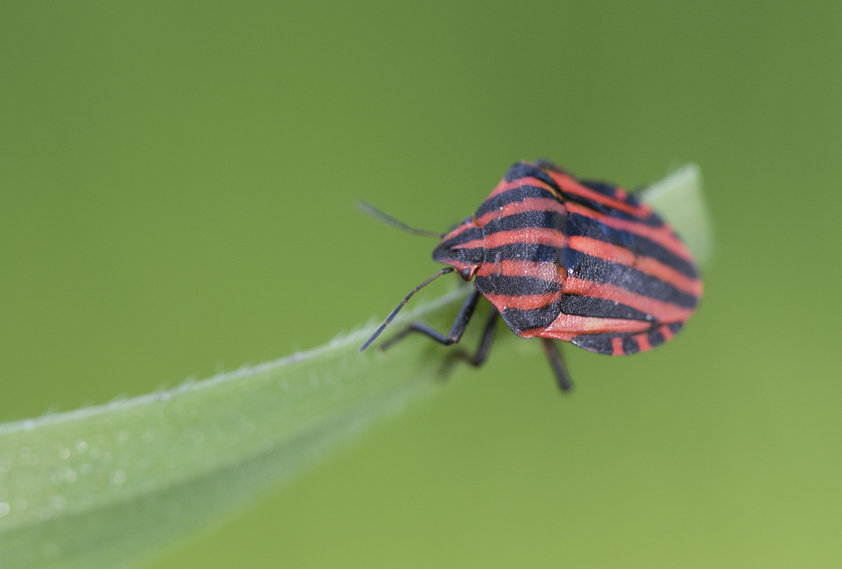Insects in your turf grass can be a nuisance specially during the growing season. Successful management of them depends upon early detection before they reach damaging levels. This can be accomplished through frequent turf inspections, looking for early signs of insect damage, ensuring that the pest is present, and administering the appropriate controls.
There are many types of insects that feed on turf grass. Here are just a few examples and the appropriate methods for identifying them.
Sod webworms
Sod webworms are the turf-damaging larvae of the sod webworm moth. The young sod webworm matures to about 1-inch in length and becomes brown or green in color with dark spotting. The gray-tan adult moth has a distinctive protrusion that looks like a double snout.
Sod webworms eat grass blades and entire stems, leaving brown patches behind. Their damage is swift and extensive. The turf is often riddled with holes from birds foraging for worms, and silken tunnels are found at turf level.
To identify them, mark off a 1-square-yard area in a location of suspected infestation. Mix two fluid ounces of liquid dishwashing soap in four gallons of water and drench the area with the solution. Insects should emerge to the grass surface. Kneel to observe the area quickly as insects will return to the soil in 5 or 10 minutes. If no insects are found, examine other suspected areas. Treat if you find in the one square yard area an average of 40 or more sod webworms.
Armyworms
Much like their name implies, armyworms do battle with your lawn. These 1- to 2-inch-long pests vary in color, from gray to yellow to pink, depending on type. Armyworms turn into brown moths that are easy to distinguish at night. As they gravitate toward light, they reveal their furry abdomens.
Armyworms eat grass blades and stems and skeletonize leaves on other plants. They generally take shelter from sun and heat during the day and feed most heavily on your lawn in the evening, at night, or early in the morning. As the worms eat the grass, they create circular bare spots in lawns. When invasions are heavy, the lawn appears to move. To identify them, follow the same directions above for sod webworms.
Chinch bugs
Several types of chinch bugs attack turf grass including the common hairy chinch bugs, which inhabit different areas of the country. Chinch bugs are sap-sucking insects that feed by sucking on grass blades. While feeding, they secrete an anticoagulant that causes grass to stop absorbing water. As a result, the grass withers and dies.
Chinch bug damage to lawns is most visible from June to September, when the bugs are actively feeding. Irregular patches of turf first take on a purple tinge, and then wilt, yellow, and turn brown.
To properly identify chinch bugs, insert a large metal can – with each end cut out – into the turf in an area where the grass is yellowed and declining. Fill the can with water and wait five minutes for the chinch bugs to float to the top of the water. Examine three or four places in the suspected area. Parting the grass to observe the soil surface for chinch bugs also works. Treat if you find an average of 20 or more chinch bugs per square foot.
White grubs
Among the most damaging of all lawn pests, white grubs are the larvae of a wide variety of scarab beetles, including masked chafers and Japanese beetles. During the spring, summer and early fall months, these c-shaped larvae feast on lawn grass roots just below the soil surface.
You will begin to see wilted grass blades followed by brown turf patches and eventual death if you have grub damage. If you see skunks, moles, or crows feeding on your lawn, they are most likely searching for a grub meal.
To identify grubs, cut three sides of a 1-square-foot piece of sod about three inches deep with a spade at the edge of one of the off-color areas in the turf. Pull or pry the sod back like a flap to check and soil and examine roots for chewed off remnants. Treat if you find three or four grubs per square foot.
Other Insects
Other insects than those listed above can also infiltrate your turf grass. So, it is important to regularly examine it, always checking where the damaged area meets the green, healthy grass. That is where the insects are likely to be most abundant.
Treatment
There are many ways to treat turf insect pests, most of which you can find via a general Internet search. If you think you have an insect pest and can only get rid of it with an insecticide, it is best to contact a landscaper, turf professional, extension agent or entomologist for current recommendations and restrictions. If chemical control is required, select an appropriate insecticide, follow label directions, and apply only to infested areas. Keep children and pets off treated areas until the spray has dried. Above all, don’t be impatient. It may take several days after treatment to achieve control of surface-active insects and longer for soil-active insects.

